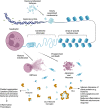Clusterin Neutralizes the Inflammatory and Cytotoxic Properties of Extracellular Histones in Sepsis.
Augusto JF, Beauvillain C, Poli C, Paolini L, Tournier I, Pignon P, Blanchard S, Preisser L, Soleti R, Delépine C, Monnier M, Douchet I, Asfar P, Beloncle F, Guisset O, Prével R, Mercat A, Vinatier E, Goret J, Subra JF, Couez D, Wilson MR, Blanco P, Jeannin P, Delneste Y.
Augusto JF, et al.
Am J Respir Crit Care Med. 2023 Jul 15;208(2):176-187. doi: 10.1164/rccm.202207-1253OC.
Am J Respir Crit Care Med. 2023.
PMID: 37141109


